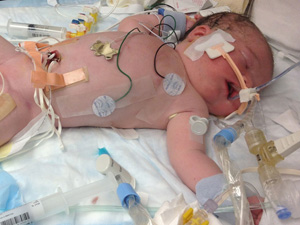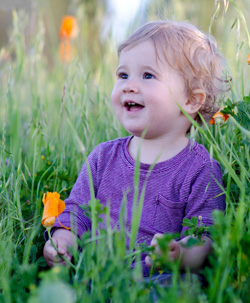September 23, 2013
Center for complex pregnancies, at-risk newborns

Eloise required expert coordinated care when she was born with a serious congenital condition.
Eloise required expert coordinated care when she was born with a serious congenital condition. Today she is a lively and healthy toddler. Zoë Bower was 18 weeks pregnant when she and her husband, Dan Edelstein, received devastating news during a prenatal ultrasound: The fetus had a hole in the diaphragm muscle that normally separates the chest and abdomen.
The hole, called a congenital diaphragmatic hernia (CDH), would make breathing impossible at birth. It had already allowed the fetus's developing intestines to move into the chest and crowd the growing lungs. The prognosis for a fetus with CDH is uncertain. Bower and Edelstein had been eagerly anticipating a second child, but now they wondered if there was any hope for this pregnancy.
The couple consulted with physicians at the Center for Fetal and Maternal Health at Lucile Packard Children's Hospital, a team with deep experience in explaining fetal diagnoses, managing complex pregnancies and caring for high-risk infants and children. Since it opened in 2009, the center has helped more than 1,000 families through complex medical problems that threaten the health of the fetus, the mother or both, through comprehensive continuum-of-care plans.
"Our aim is to provide outstanding care to women carrying fetuses with complex anomalies starting before their infants are born," said neonatologist Susan Hintz, MD, the center's medical director and a professor of pediatrics. At any given time, the center's physicians, coordinators and nurse practitioners follow 65 to 75 pregnant women-40 percent of whom travel more than 80 miles to obtain their expertise. The team includes experts from every subspecialty at Packard Children's, from maternal-fetal medicine physicians to neonatologists, radiologists, geneticists and other medical and surgical specialists who treat critically ill babies.
"We really needed to know: Is this hopeless or can we make a go for it?" Bower said, recalling her first consultation with the center's physicians. CDH carries serious risks, but depending on the prenatal findings, and with expert medical and surgical care, many patients thrive, the Packard physicians told her.

Eloise is a lively and healthy toddler.
"It's hard to describe how incredibly soothing-not naively optimistic but just caring-they were," Edelstein said. "They spent at least an hour with us, answered every question we had and gave us hope."
The team began planning for the arrival of a baby girl who would be named Eloise. The parents received hands-on preparation for her birth, including a tour of the Packard Children's Neonatal Intensive Care Unit and an introduction to the different kinds of breathing-support machines that might help Eloise after her birth.
"It made a big difference, being able to see these things beforehand," Bower said. "There were two CDH babies in the NICU when we visited, and we were even able to talk to their parents. That was an aspect of care you wouldn't get if there wasn't a center coordinating everything."
Meanwhile, Hintz and the fetal center coordinators made sure that all the Packard Children's experts who needed to weigh in had consulted on Eloise's case.
"Knowing that multiple people were reviewing the diagnostic tests and looking at them from different angles, with different expertise, was very reassuring," Bower said.
About 15 caregivers were present when Eloise was born and provided immediate care that included inserting a breathing tube within 30 seconds of her birth. Edelstein went with the care team to the NICU and watched as they worked to help his newborn daughter breathe.
"They were trying to stabilize her; it was really scary," he recalled. "It took nine hours of intense attention from the medical team." Eloise eventually got enough oxygen from an oscillator, a specialized ventilator that keeps the lungs continuously open.
Nine days later, Eloise received the surgical repair she needed: a Gore-Tex patch to close the hole in her diaphragm. She made a slow but steady recovery, and headed home at 6 weeks.
A few days later, a gastroenterologist at a check-up told her parents it was time to remove the nasogastric feeding tube that had been helping the fragile infant get enough nutrition.
"She was finally wireless," Edelstein said. "That's when she really felt like a normal baby."
About Stanford Medicine
Stanford Medicine is an integrated academic health system comprising the Stanford School of Medicine and adult and pediatric health care delivery systems. Together, they harness the full potential of biomedicine through collaborative research, education and clinical care for patients. For more information, please visit med.stanford.edu.